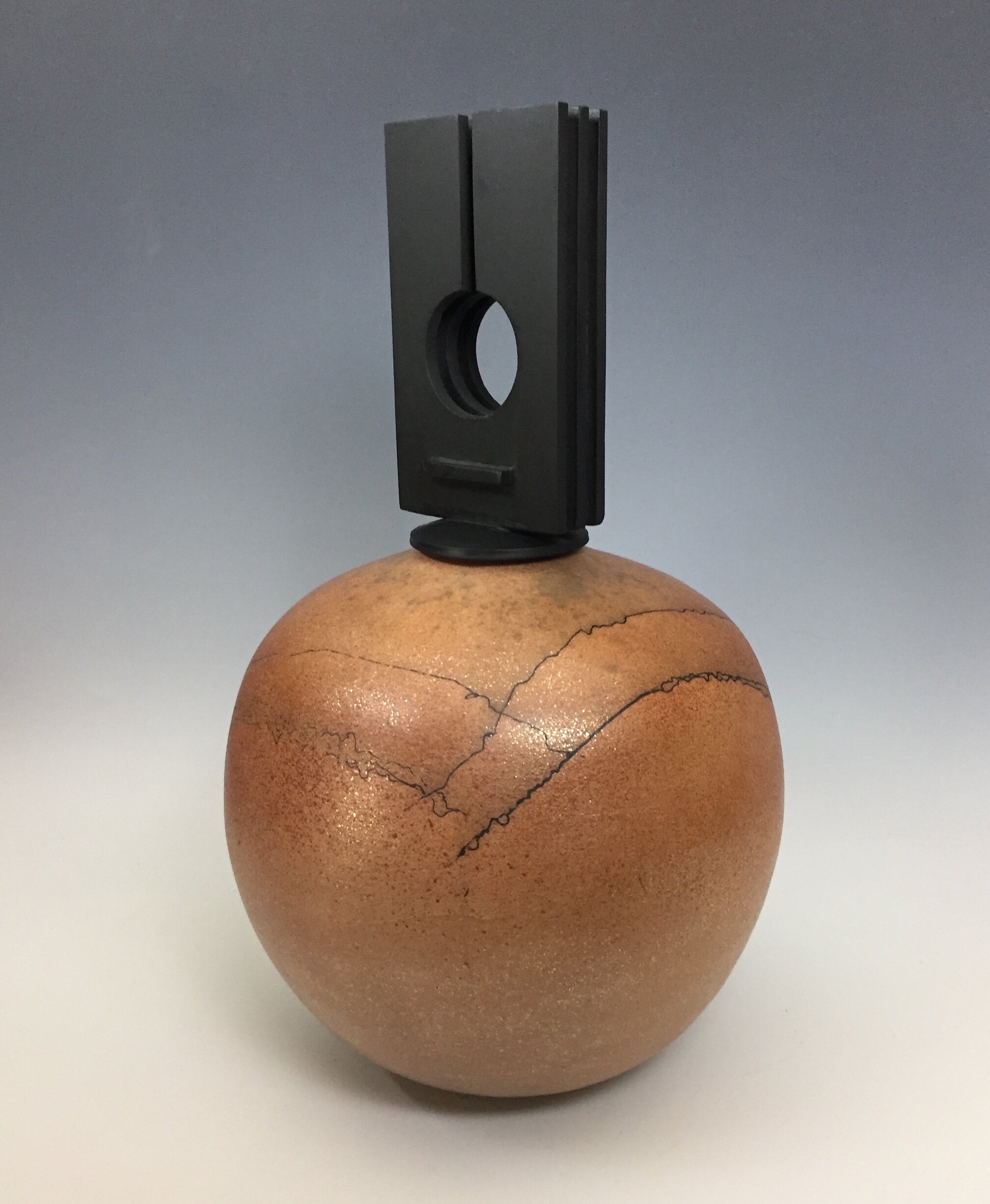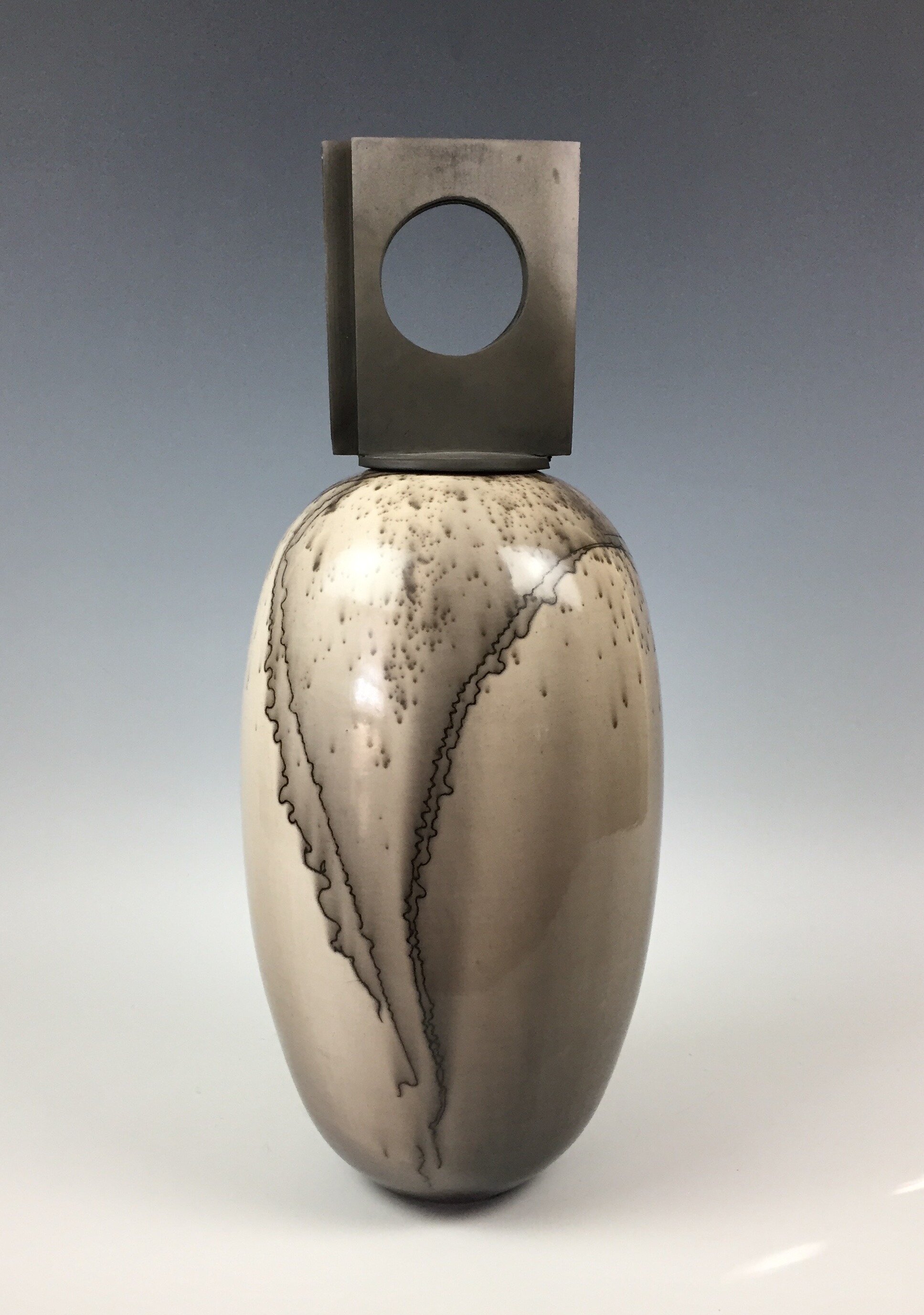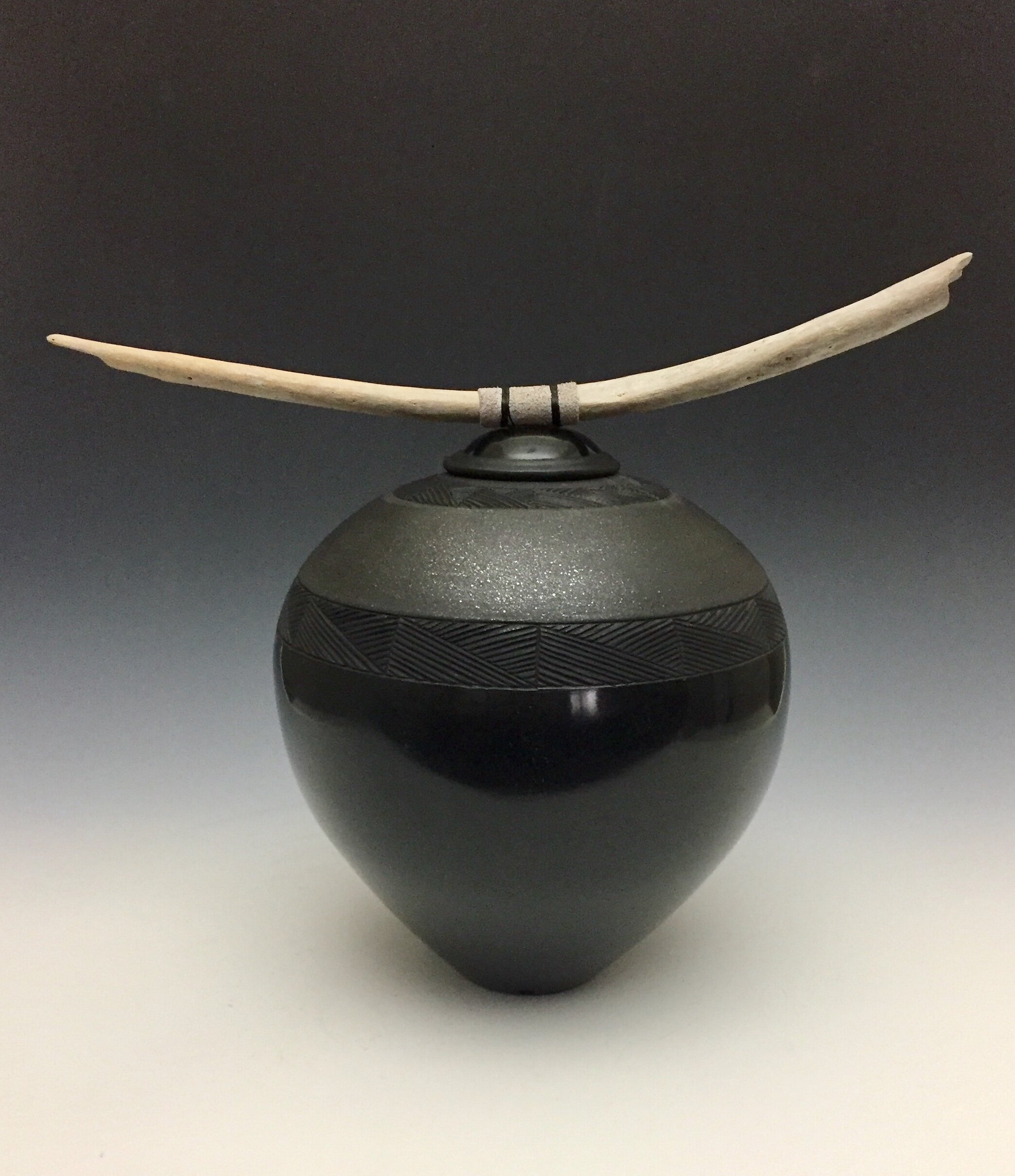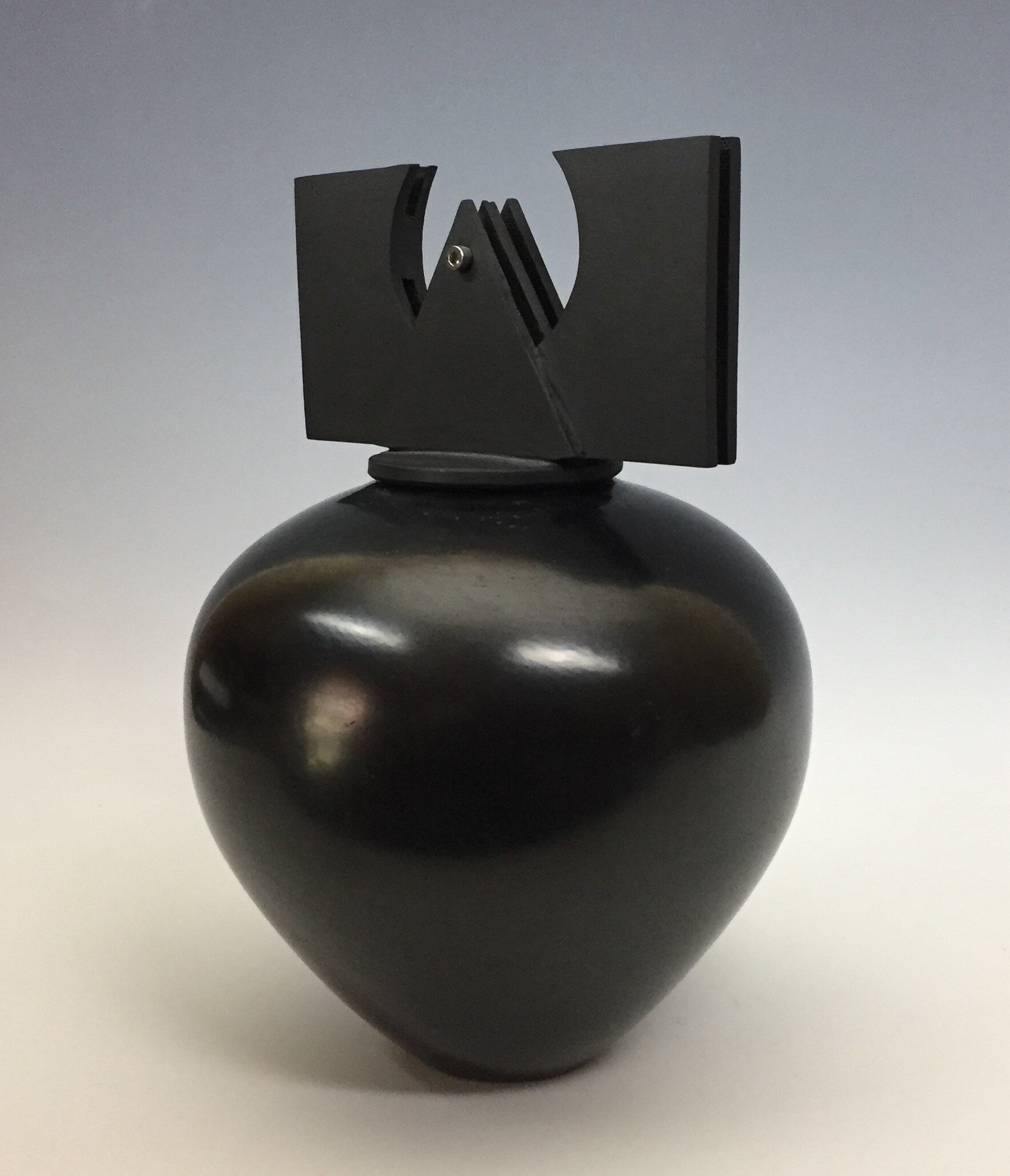Interview with artist Winston Taylor
Winston Taylor is a ceramic artist living and working in Russellville, Arkansas. His vessels combine an elegant, often traditional form with an industrial and graphic feel. Named an Arkansas Living Treasure in 2011, Winston has continued to produce extraordinary works that are sought after by many collectors. He is represented by Boswell Mourot Fine Art in Little Rock and more of his work can be seen at winstontaylor.net.


AAS: Winston, I know you are originally from Little Rock. Would you talk more about your background and how you ended up in Russellville?
WT: I was born in Little Rock where I lived and worked until 1990. I attended public schools and graduated from Hall High School in 1967. I joined the Air National Guard and was activated to serve during the Pueblo Incident as an aircraft electrician in Japan. After discharge I attended UALR for a couple of years and then began a nine-year stint in automotive body repair. During that time, I married Kristen and we have a daughter, Megan. After leaving the auto body repair trade I reentered UALR and received my BA in Arts degree with an emphasis in ceramics. While attending college I worked in home construction. After graduation I secured a job at River Valley Arts Center as Artist in Residence, and we moved to Russellville in 1990. We have lived there since.
AAS: Growing up, were you interested in art? Did anyone in your family inspire your artistic interests?
WT: I have always been interested in art. My father was a self-taught painter and I loved watching him paint. I also have an intense interest in cars and began dreaming of designing them. I did design some and once won an award from the GM Craftsman Guild when I was a senior in high school. When I began my degree in art at UALR my emphasis was in graphic design. I took pottery as an elective in my degree plan and found my first love in that medium. I also enjoyed drawing and took several courses in that medium. I did fairly well with the other mediums I explored, but it was the clay that captured my heart.
Black On Black Series, driftwood top, 12” x 13”
AAS: Winston, let’s talk now about some of your recent extraordinary vessels. Your Black On Black Series is stunning in its elegant appearance and the use of natural material. Would you talk about what inspired that series and how they are created?
WT: I have taken several workshops in clay. One was in creating Blackware in the traditional method of the Southwest Native American potters at Western State University in Gunnison, Colorado My instructor was Adelphia Martinez, niece of Maria Martinez. We learned to coil build red earthenware pots, sanding and burnishing them with glassy smooth stones and firing them in cow manure mounds, just as her ancestors had done for several hundred years. I have adapted my own firing method and use the potter’s wheel to construct them. My designs are inspired by my interest in geometric and mechanical design. Somewhere along the way I discovered that found deadwood juxtaposed with the formal elegance of the black vessel works.



Spirit Bear, Raku with labyrinth pattern, 13” x 9”
AAS: You created some Raku vessels with a labyrinth pattern. They are marvelous. Would you talk about the Raku firing process and the glazes used?
WT: The Raku firing technique has its origin in the early 1500’s in Japan. The making of ceremonial tea ware by Buddhist monks were the earliest examples of Raku. In the 1950’s the process was brought to the United States and one of the potters credited most frequently was Paul Soldner. In the mid-1990’s I was privileged to attend a seven day workshop taught by Paul at Anderson Ranch Art Center in Snowmass Village Colorado. Actually I developed my interest of Raku more than ten years earlier as a student at UALR. It was there that I built my first Raku kiln at the school. I was intrigued by the spontaneous nature of the process, the hands on involvement throughout and the magical results when there was success.
Winston tending to his Raku kiln.
Many Raku potters build their own kilns using gas but electric kilns may be used also. The kiln is heated rather quickly to usually more than 1500 Fahrenheit. The ware is removed quickly with tongs and placed in combustible materials and quickly covered. It cools in the container and changes take place with certain glazes due to the deprivation of oxygen (called reduction). After the ware is cooled enough it may be quenched with water. Timing is crucial in all stages and that is learned through trial and error. Another thing I love about Raku is its meaning – enjoyment or joy.
Raku Labyrinth, 12” x 9.5”
AAS: The firing and glazing process is not completely in a potter’s control. That spontaneity and surprise – is that something you enjoy and look forward to?
WT: Clay is pretty forgiving until it’s fired and then it permanently changes. Sometimes the outcome is promising, even successful and other times the results are disappointing. If a ceramic artist is always trying new things as I do, all of those things will happen. I cannot honestly say I enjoy it all. Thankfully, I achieve results I’m pleased with often enough to keep me going, especially as the years roll by and I gain experience.
AAS: There are so many variables in the creation of the final shape and appearance. Did you develop most of your techniques by trial and error?
WT: I’ve gained my knowledge in ceramics from both formal training at UALR and taking workshops in specific techniques. Taking what I’ve learned from others, I have always experimented on my own which produces my art. As I’ve alluded to before, experience seems to produce more trials with favorable outcomes than errors. I’m a great believer in patience and perseverance.
Saggar Fired Bottle, 10” x 9”
AAS: You’ve done a number of saggar-fired vessels which have the most beautiful finishes – either a glassy finish or almost a corrosive finish. What is the Saggar firing process?
WT: In recent years I’ve used a technique called saggar firing. A saggar is a container in which a clay object is placed and the space around it is filled with volatile materials like metal sulphates, oxides, salts, copper wire, steel wool, etc. In my work I choose metal containers or a wrapping of aluminum foil. A glassy surface is achieved by first sanding a dry pot then moistening it slightly with a combination of baby oil and water. Immediately after the moisture has soaked in I begin burnishing in a cross hatching manner until the surface is shiny and void of dull areas. The process may take more than a hour and must be done without stopping. I enjoy the process finding it meditative.
Other saggar fired pieces may have a dry sandy surface which is the result of using a coarser clay body called stoneware. these omit the burnishing process. With both methods there is a risk of cracking pieces due to thermal shock so nice color and no cracks are treasured results. I fire them in a Raku kiln and slowly raise the temperature to avoid that result. The pieces are never exactly the same although there general similarities in the effects, something I enjoy.
Saggar Fired Modern Industrial Series, 13” x 10”
Spirit Bear, Raku with horsehair, 10” x 9”
AAS: Is the bear your spirit animal? I love your horsehair pot with the Spirit Bear top.
WT: The Spirit Bear is my self-assigned spirit animal. I discovered the Spirit Bear in my workshop with Adelphia Martinez. I noticed she used the uniquely shaped bear frequently in her designs. I asked her what it meant and was told it symbolizes patience, perseverance and strength. What qualities for a potter, or anyone for that matter! I adopted the symbol as part of my signature and even have a Spirit Bear earring. I have discovered these qualities must be practiced and I often have to make myself aware to employ them. The Spirit Bear is a part of many of my pieces that are black fired, Raku fired, or horsehair fired. Here you see an example of one that is horsehair fired and fumed with ferric chloride. Ferric Chloride produces the reddish-orange color that you see here. I also pour this chemical over my pieces before saggar firing.
Raku Vessel, horsehair fumed with ferric chloride, driftwood, 9” x 10”
AAS: Your work often incorporates geometric shapes and surface features and textures. Do you consider yourself a very analytical and tactile person?
WT: Many of my pieces in recent years incorporate geometric tops and textures that reflect shapes seen in machines, architecture or industry. I am one that can be inspired by structures I see, or even scraps laying on a machine or wood shop floor. I think it goes back to my roots as a mechanic and a carpenter. I am sometimes drawn to elements of a graphic design and find a way to interpret what I have seen in the tops of some of my pieces. I love to build and fit together precisely cut or carved shapes of clay. I think my vessels become sculptures when a top like that, or even driftwood or stone is an added element of design.


AAS: Has your style changed over the years and do you also make ‘functional’ pottery.
WT: I was heavily influenced by the workshops led by Martinez and Soldner. For a while, I imitated their styles of design. After a time, I moved back to my own style that we’ve talked about here. I like vessels that have a buoyant shape, contrast and limited palette in a minimal composition.
I also make mugs, bowls and other pieces that can be used for food or drink. I also have made sinks, countertop tiles and bas-relief sculptures. My sinks and counter tiles are installed in numerous homes around Arkansas and one in the Outer Banks of North Carolina. The bas-relief sculptures are installed at First United Methodist Churches in Russellville and Fort Smith. I also have three tile murals installed in Russellville High School Center for the Arts. I will install a fourth this summer.
AAS: Winston, you have earned to many awards including the Arkansas Living Treasure Award in 2011. That must be very gratifying.
WT: I’ve enjoyed a long career creating and teaching my art. The awards I’ve received are most gratifying because they were not applied for but simply given. Receiving Arkansas Living Treasure in 2011 was a huge honor to me. Only one is given each year and my work was scrutinized and deemed exceptional by a experienced and knowledgeable panel. One of them commented that I was on top of my game, a comment I shall never forget that motivates me still. I also received a Rotary International Award for Vocational Excellence and named a Paul Harris Fellow in 2010. It was recognition for founding and teaching a multi-media visual art program in elementary schools in our area. This was before art was made part of public elementary curriculum. I called my program Kids-at-Art and designed the program with much help from my wife, Kristen (an elementary public school teacher) and the then executive director of The River Valley Arts Center, Thea Ryan. I also received the Arkansas Arts Award for Art Education from the Arkansas Arts Council in 1993 for the Kids-at-Art program. I received a Beaux Arts Award from The River Valley Arts Center as Artist of the Year. Most recently I received recognition for founding the ceramics studio and my thirty years of teaching there.
These awards and recognition could have never been possible without the support and encouragement from my wife, Kristen, through all the lean years. I was also blessed with support from the community of Russellville and River Valley area. I’m forever thankful for them and the gifts I’ve been given.
AAS: Your vessels really call out to be touched and even held. How do you hope people will react when they look at a Winston Taylor vessel?
WT: I am most gratified when people recognize my vessels as elegant, contemporary, unique or interesting. Those are my goals and comments like these are inspiring and motivating. I am reminded of someone who has commented on how she loves the smooth surfaces of my stone polished pieces. I feel like I have succeeded when I hear things like that.


